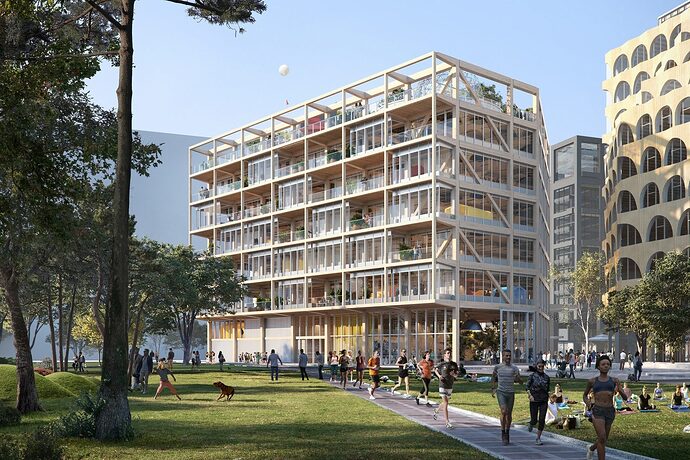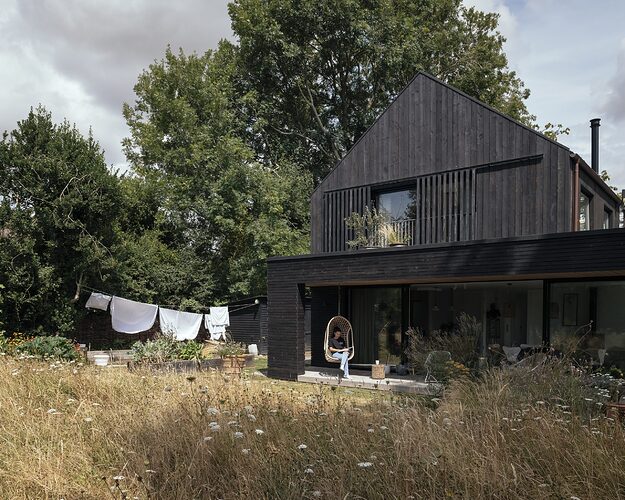Government to announce roadmap for boosting use of timber in housebuilding
7 DECEMBER 2023 · BY ANNA HIGHFIELD
Brent Cross South offices by Hawkins\Brown
Source: Hawkins\Brown
The government is set to announce a timber-house-building roadmap to push for lower embodied carbon in the construction of England’s homes
The Department for Environment, Food and Rural Affairs (Defra) said it would shortly announce ‘a roadmap of policies to boost the use of timber in construction’ in England.
Environment secretary Steve Barclay is expected to make the announcement at COP28, taking place in Dubai this week.
Under the plans, Defra might cap the embodied carbon used in housebuilding materials, reports The Times.
As the AJ reported more than a year ago, the government has pledged to ‘explore the potential of embodied carbon limits for buildings in the future’, although it also rejected Tory MP Jerome Mayhew’s private members’ bill that sought to regulate embodied carbon, sparking fury from climate activists in the industry.
If the Defra proposals are enacted and the cap is set low enough, housebuilders could be forced to use timber frames as a low-embodied-carbon alternative to materials such as concrete and steel.
The government has promised to work with the industry to measure and reduce embodied carbon in new buildings by 2025.
Source:Jim Stephenson
Black Timber House by HAPA Architects
Its Timber in Construction Roadmap is a joint document being developed between government departments Defra, the Department for Energy Security and Net Zero (DESNZ), the Department for Levelling Up, Housing and Communities (DLUHC), and the Department for Business and Trade (DBT), alongside ‘industry, and other stakeholders’.
The sector-specific roadmap aims to ‘set out the current landscape and future potential for the use of timber as a sustainable construction material’, and is set to include both industry and government commitments to increase timber use in construction.
The roadmap acknowledges a need for the government to work with the industry to address the fire risks in timber buildings, following the industry’s ‘rightly’ renewed focus on building safety since the Grenfell Tower disaster in 2017.
Earlier this year, Defra explained that the roadmap was being developed in parallel with a national wood strategy to boost wood production and its use in England, led by industry leaders and the Confederation of Forest Industries (Confor).
In a letter in June, the department explained that stakeholders had called for a ‘timber sector deal’ to follow both strategies. This, it said, could align with both the timber roadmap and the national wood strategy to provide ‘a mechanism for government and industry to agree a shared action plan to support, maintain, and grow the timber and wood processing sectors’, providing more details on how government and industry commitments and proposals would be implemented.
At the time, Defra said it was ‘only at the very early stages of scoping what a sector deal in response to these documents may look like, and no formal commitment has been made by government’. The AJ has asked the department for an update on the deal.
Also launched at COP 28 this week is a Buildings Breakthrough initiative, led by France and Morocco in partnership with the UN Environment Programme (UNEP). This aims to encourage ‘international collaboration to decarbonise the building sector … making near-zero emissions and climate-resilient buildings the new normal by 2030’.
The declaration, which 27 countries have signed up to, including the UK, commits countries to ensure any new building project completed after 2030 exceeds a 40 per cent reduction in embodied carbon emissions compared with current levels. Other commitments include prioritising the use of retrofit and reclaimed and low-carbon materials.
Sustainable design and embodied carbon specialist Philip Oldfield, head of the built environment school at the University of New South Wales (UNSW), though originally from Derby, told the AJ: ‘There’s robust evidence that using timber as an alternative to concrete can reduce embodied carbon in buildings, so I welcome more timber housing.
‘But it’s no silver bullet in reducing carbon emissions. If we are truly to tackle the embodied carbon challenge we need to retrofit more often, build smaller, and recycle and reuse materials far more radically.’
Louise Hutchins, head of policy and public affairs at UK Green Building Council, said: 'This is good news and long overdue. Regulation to require industry to reduce embodied carbon emissions has been largely missing in action, but is critical to the UK meeting its climate commitments, particularly as both major parties are planning a boom in new developments.
‘With our new analysis showing the UK built environment has only achieved a quarter of the embodied emissions reductions needed in the last four years, limits on embodied carbon, together with low-carbon materials including sustainably sourced timber, will be vital to getting us on the right track.’

